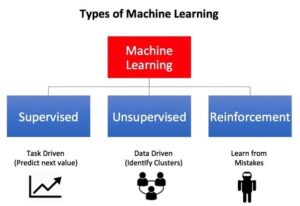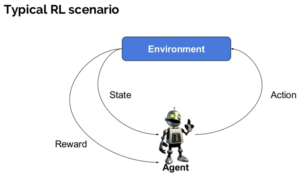Machine Learning (ML) is a form of artificial intelligence (AI) that permits software applications to be more precise in forecasting results without explicitly planning to do so. Machine Learning algorithms practice historical data such as input to forecast new output ethics.
Recommendation engines are a common way to use machine learning. Other general uses include fraud detection, spam filtering, malware hazard detection, business automation process (BPA), and speculation retention.
Types of Machine Learning
Classic machine learning is often separated by how the algorithm learns the most exact of its forecasts. There are four basic methods: supervised learning, and enhanced reading. The type of algorithm the data scientist selects to use be contingent on the type of data they need to predict.
Supervised learning: In this type of machine learning, data scientists provide algorithms with categorized training data and define variables that they need the algorithm to test for integration. Mutually input and output algorithms describe.
Unsupervised learning: This type of machine learning includes algorithms that train data without labels. The algorithm scans over data sets that require any meaningful relationship. Both data algorithms trains and forecasts or references are issues in advance.
Semi-supervised learning: This method of machine learning includes the combination of these two previous types. Data scientists can supply a multi-data algorithm with a training label, but the model is free to test the data on its own and improve its understanding of preset data.
Reinforcement learning: Learning reinforcement is often used to teach a machine to complete a multi-step procedure where there are clearly defined rules. Data scientists set up an algorithm to complete the task and then offer it a good or negative guide as to how to complete the task. But for the most part, the algorithm decides for itself which steps to take.
How Supervised Machine Learning Works
Supervised machine learning needs a data scientist to sequence the algorithm with all the inputs included and the desired results. Supervised learning algorithms are suitable for the following tasks:
Binary division: Dividing data into two classes.
Multiple categories: Selection between more than two types of responses.
Postponed modeling: Predicting continuous prices
Combine: Integrating forecast of multiple machine learning models to create accurate predictions.
How Unsupervised Learning Works
Unsupervised machine learning algorithms do not need the data to be labeled. They filter unlabeled data to see for patterns that can be used to collect data points in subsets. Many types of in-depth learning, including neural networks, can be controlled algorithms. Unsupervised learning algorithms are suitable for the following tasks:
Integration: The data classification set with groups accordingly.
Anomaly Discovery: Identify rare data points in a data set.
Organizational mines: Identify the set of objects in a set of data that occurs most often together.
Decreasing Size: Reduce the value of variables in the data set.
How Semi-Supervised Machine Learning Works
Semi-supervised learning works with data scientists who feed a small amount of training data with an algorithm. However, the algorithm reads the size of the data set, which I can use for new, unlabeled data. The act of algorithms generally improves when they train themselves in labeled data sets. But labeling data can be time consuming and classy. Slightly supervised learning attacks a triad between the performance of supervised learning and the effectiveness of unchecked learning. Other areas where less supervise learning uses include:
Machine translation: Teaching language translation skills based on less than a complete dictionary.
Fraud detection: Identify fraud cases if you have a few good examples.
Label data: Algorithms skilled in small data sets can learn to use data labels in large sets mechanically.
How Reinforcement Learning Works:
Reinforcement learning works by setting up an algorithm with a different goal and set rules to achieve that goal. Data scientists also devised an algorithm for the pursuit of good rewards – which it accepts when it does a beneficial deed for the ultimate goal – and avoid punishment – which it receives when it performs a step closer to its goal. Reinforcement learning is like machine learning and repeatedly used in areas such as:
Robots: Robots can learn to achieve tasks in the physical world by utilizing this method.
Video game: Reinforcement learning has utilizing to teach bots to play certain video games.
Resource management: Given limited resources and a defined purpose, strengthening learning can help companies plan how to allot resources.


0 Comments